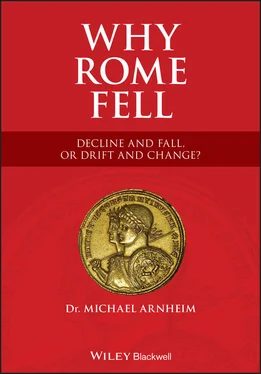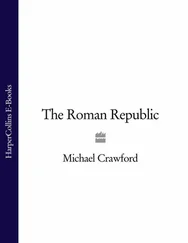Michael Arnheim - Why Rome Fell
Здесь есть возможность читать онлайн «Michael Arnheim - Why Rome Fell» — ознакомительный отрывок электронной книги совершенно бесплатно, а после прочтения отрывка купить полную версию. В некоторых случаях можно слушать аудио, скачать через торрент в формате fb2 и присутствует краткое содержание. Жанр: unrecognised, на английском языке. Описание произведения, (предисловие) а так же отзывы посетителей доступны на портале библиотеки ЛибКат.
- Название:Why Rome Fell
- Автор:
- Жанр:
- Год:неизвестен
- ISBN:нет данных
- Рейтинг книги:3 / 5. Голосов: 1
-
Избранное:Добавить в избранное
- Отзывы:
-
Ваша оценка:
- 60
- 1
- 2
- 3
- 4
- 5
Why Rome Fell: краткое содержание, описание и аннотация
Предлагаем к чтению аннотацию, описание, краткое содержание или предисловие (зависит от того, что написал сам автор книги «Why Rome Fell»). Если вы не нашли необходимую информацию о книге — напишите в комментариях, мы постараемся отыскать её.
Why Rome Fell: Decline and Fall, or Drift and Change?
Why Rome Fell
Why Rome Fell
Why Rome Fell — читать онлайн ознакомительный отрывок
Ниже представлен текст книги, разбитый по страницам. Система сохранения места последней прочитанной страницы, позволяет с удобством читать онлайн бесплатно книгу «Why Rome Fell», без необходимости каждый раз заново искать на чём Вы остановились. Поставьте закладку, и сможете в любой момент перейти на страницу, на которой закончили чтение.
Интервал:
Закладка:
The monarchy appears initially to have been not hereditary but elective, with the king being chosen by the Senate, an aristocratic council, and confirmed by the citizens meeting together in the Assembly known as the Comitia Curiata . The last three kings, Tarquinius Priscus, Servius Tullius, and Tarquinius Superbus (“Tarquin the Proud”), were reputedly Etruscans, and the monarchy seems to have become hereditary at that time, as the two Tarquins were either father and son or grandfather and grandson, and Servius Tullius was supposedly the younger Tarquin’s father-in-law.
Livy’s account of the last period of the monarchy paints a very confused picture, with Tarquinius Superbus initially cultivating the support of the Senate against Servius Tullius, his father-in-law, portrayed as a populist king, distributing conquered lands to the whole populace and enjoying widespread popular support. (Livy 1.46.1). Servius Tullius is even said to have been physically attacked by his son-in-law and murdered by Tarquin’s entourage. (Livy 1.48). Once ensconced in power, we are told, Tarquin “…killed the leading senators who he believed had favored the cause of Servius.” (Livy 1.49.2.1). This may indicate aristocratic opposition to his rule, which rather contradicts his earlier stance.
What, then, was the power-structure under the Roman monarchy? If the earlier kings really owed their position to election by the Senate, an aristocratic body, then that may point to an aristocratic regime from the start, with the king as essentially primus inter pares (first among equals). The last three kings, however, may possibly represent a period of Etruscan domination over Rome. So, the uprising that ended the monarchy may then be interpreted as the reclaiming by the indigenous Roman aristocracy of their previous pre-eminence against foreign domination. The only thing that appears to contradict this interpretation is the tradition that Lucius Junius Brutus and his co-conspirator Lucius Tarquinius Collatinus, who were chiefly instrumental in overthrowing Tarquin the Proud and would become the first two consuls of the new Republic, were both related to the king, and that Brutus had two of his sons put to death for siding with the ousted king. If there is any truth in this picture of a family feud, then it may be that Tarquin’s overthrow was the result of internecine conflict within the Roman aristocracy.
Relics of Monarchy
Long after this time, there were some telltale signs that Rome had actually been a monarchy. These included the position of interrex and that of rex sacrorum . The rex sacrorum (literally, “king of the holy”) was the patrician holder of the highest-ranking but largely ceremonial priesthood in the Roman state religion, who was in practice subordinate to the Pontifex Maximus (chief priest). The rex sacrorum , then, may be a relic of the religious functions originally carried out by the kings.
During the Republic, an interrex was elected by the Senate for five days only in order to hold elections when for some reason the consuls had been unable to do so. This office may possibly hark back to a time when there was a gap between two elective kings, causing an interregnum .
“Republic” and Democracy
The English word “republic” is a translation of the Latin res publica . The Latin adjective publica is a contraction of the non-existent * populicus , from populus , “the people.” So, res publica means, literally, “the people’s thing, the people’s business,” hence “public or civil affairs, public or civil administration, public or civil power,” and hence “the state, commonwealth, republic.” (Lewis & Short.) It generally refers to the Roman state, as against foreign states, for which the word civitas was preferred, and from which (via the French) we have the English word “city.”
It is important to note that, in referring to the Roman state, res publica did not identify any particular form of government and was still used to refer to the Roman state long after the Roman Republic had ceased to exist and when Rome was ruled by emperors. For example, in the dedication by Pliny the Elder (23–79) of his Historia Naturalis (Natural History) to the future Emperor Titus, he congratulates Titus on his service to the state , this term being expressed by res publica , written in 77, more than a century after the end of the Roman Republic. (Pliny, Natural History , 3.)
The term res publica clearly, therefore, carries no implication of democracy even though it is based on the word populus , meaning “the people,” The acronym SPQR , for Senatus Populusque Romanus (The Roman Senate and People), a corporate designation of the Roman state, likewise carries no implication of democracy and is also not associated with a republican form of government. In fact, it is first encountered only in the late Republic and continued to be used well into Imperial times. Both the Arch of Titus, dating from 81 (CIL VI 945), and the Arch of Septimius Severus, constructed in 203 (CIL VI 1033), were dedicated to the memory of these emperors by The Roman Senate and People, the latter well over two centuries after the demise of the Roman Republic.
From One Brutus to Another
Whatever the precise explanation may be for the overthrow of the monarchy, there can be no doubt about the nature of the republic which replaced it. Far from being a democracy, it was controlled by a hereditary aristocracy that gradually morphed into an oligarchy. “Oligarchy,” from the Greek, means literally “the rule of the few,” whereas the literal meaning of “aristocracy,” also of Greek origin, is “the rule of the best.” Aristotle (384–322 BCE) used both terms to refer to minority rule, aristokratia being the “good” form and oligarchia the “bad” or “perverted” form. (Arist. Politics III.7.) My own usage of these terms is rather different. Aristocracy refers to rule by a hereditary elite and also to the membership of that elite, while “oligarchy” is used to refer to a non-hereditary ruling elite. And it is worth noting the Latin term res publica or respublica (republic) did not refer to the type of government or power structure but was a much more general term meaning essentially “the Roman state.” (See sidebar).
According to our sources, the Latin word rex (king) and the whole idea of monarchy were taboo in the Roman Republic (and long afterward), which makes perfect sense because what an oligarchy dreads most is a strong ruler supported by the masses. But, as the history of the late Republic demonstrates, it would be a mistake to assume that this fear of monarchy was shared by the populace at large. Indeed, in times of crisis, the ordinary people would look to a strong leader to champion their cause against the oligarchy.
The Republican constitution, meaning the creation of the ruling oligarchy, was carefully constructed so as to prevent power from being concentrated in the hands of any one person. One of its main features was collegiality, or shared power, together with short terms of office, and rotation. The chief offices and institutions of state included the following:
Consuls: The king was replaced by two consuls with equal authority elected for a year at a time, each with the right to veto the other’s actions. They alternated in holding supreme power imperium (supreme power) month by month. According to tradition, the consuls (possibly originally called praetors) had to be patricians until the Lex Licinia Sextia of 367 BCE threw the consulship open to plebeians as well, and the Lex Genucia of 342 BCE, which reserved one consulship for a plebeian every year but permitted both consuls to be plebeians (Livy 7.42.), The Lex Genucia also laid down the rule that a ten-year gap had to be left before an office-holder could be elected to the same office for a second term, but this was repealed in 217 BCE. (Livy 27.6.7.)
Читать дальшеИнтервал:
Закладка:
Похожие книги на «Why Rome Fell»
Представляем Вашему вниманию похожие книги на «Why Rome Fell» списком для выбора. Мы отобрали схожую по названию и смыслу литературу в надежде предоставить читателям больше вариантов отыскать новые, интересные, ещё непрочитанные произведения.
Обсуждение, отзывы о книге «Why Rome Fell» и просто собственные мнения читателей. Оставьте ваши комментарии, напишите, что Вы думаете о произведении, его смысле или главных героях. Укажите что конкретно понравилось, а что нет, и почему Вы так считаете.












